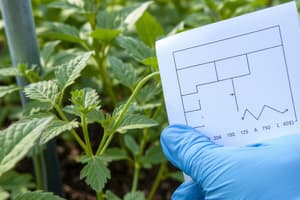Podcast
Questions and Answers
Describe the definition of a quarantine pest.
Describe the definition of a quarantine pest.
A quarantine pest is one of potential economic importance to an area that is present but not widely distributed and is being officially controlled.
What are the two primary objectives of plant protection in agriculture?
What are the two primary objectives of plant protection in agriculture?
To augment crop production and improve the quality of produce.
What is the significance of the legislative measures in plant quarantine?
What is the significance of the legislative measures in plant quarantine?
Legislative measures regulate the movement of planting materials to prevent the introduction and establishment of exotic pests.
List two pests that have had significant international spread and their affected regions.
List two pests that have had significant international spread and their affected regions.
Explain the role of ISPM guidelines in pest risk analysis.
Explain the role of ISPM guidelines in pest risk analysis.
What are the potential outcomes of failing to effectively manage quarantine pests?
What are the potential outcomes of failing to effectively manage quarantine pests?
What types of organisms are classified as pests under the provided definition?
What types of organisms are classified as pests under the provided definition?
Why is it important to prevent the inadvertent introduction of exotic pests?
Why is it important to prevent the inadvertent introduction of exotic pests?
What are the initial steps involved in the initiation of the Pest Risk Analysis (PRA) process?
What are the initial steps involved in the initiation of the Pest Risk Analysis (PRA) process?
How does capacity building contribute to effective pest risk assessment?
How does capacity building contribute to effective pest risk assessment?
What is the significance of adhering to ISPM guidelines during the PRA process?
What is the significance of adhering to ISPM guidelines during the PRA process?
Describe the role of networking among DPP, ASEAN, and NPPOs in pest risk management.
Describe the role of networking among DPP, ASEAN, and NPPOs in pest risk management.
What are the components involved in identifying commodities prioritized for export during PRA?
What are the components involved in identifying commodities prioritized for export during PRA?
Explain the purpose of the final policy determination step in the PRA process.
Explain the purpose of the final policy determination step in the PRA process.
What does the appeal process involve after the release of the final PRA report?
What does the appeal process involve after the release of the final PRA report?
In what way does enhanced plant protection facilitate trade according to the PRA framework?
In what way does enhanced plant protection facilitate trade according to the PRA framework?
What are the three primary stages of Pest Risk Analysis (PRA)?
What are the three primary stages of Pest Risk Analysis (PRA)?
Why is economic impact assessment crucial in pest risk management?
Why is economic impact assessment crucial in pest risk management?
Define a quarantine pest and explain its significance.
Define a quarantine pest and explain its significance.
List two ISPM guidelines directly related to Pest Risk Analysis.
List two ISPM guidelines directly related to Pest Risk Analysis.
What role does Stage I of the PRA process play?
What role does Stage I of the PRA process play?
Explain the relevance of ISPM 15 in international trade.
Explain the relevance of ISPM 15 in international trade.
What factors are included in the economic impact assessment of pests?
What factors are included in the economic impact assessment of pests?
In the context of the case study, what is the primary concern regarding the import of canola seed from Canada to Pakistan?
In the context of the case study, what is the primary concern regarding the import of canola seed from Canada to Pakistan?
What distinguishes regulated non-quarantine pests from quarantine pests?
What distinguishes regulated non-quarantine pests from quarantine pests?
How does pest categorization contribute to the PRA process?
How does pest categorization contribute to the PRA process?
Flashcards are hidden until you start studying
Study Notes
Plant Protection Overview
- Plant protection aims to augment crop production and improve the quality of produce.
- It plays a critical role in agriculture and international trade, particularly through quarantine legislation.
Plant Quarantine
- A regulatory measure targeting the movement of planting materials, products, and soil to prevent exotic pests' introduction.
- Key goal is to control potential economic threats from pests that are not widely distributed.
Definition of Pests
- Pests include any species or pathogenic agents injurious to plants, such as insects, nematodes, fungi, and bacteria.
- Quarantine pests are economically significant and are under official control but are not widely dispersed.
Examples of International Pest Spread
- Late blight of potato from Central America to Europe.
- Powdery mildew and downy mildew of grapes between the USA and France.
- Chestnut blight from the USA to Orient and boll weevil from Mexico to the USA.
Pest Pathways
- International Standards for Phytosanitary Measures (ISPM) include guidelines for pest risk management (e.g., ISPM 12, 13, 15).
- These protocols address various pathways including seed and wood packaging material.
WTO - SPS Regime
- Enforces standards for trade, focusing on review and harmonization of pest management norms.
- Encourages the development of Pest Risk Analysis (PRA) and identification of Pest Free Areas (PFA).
Pest Risk Analysis (PRA) Framework
- PRA involves assessing pest risks through structured stages: initiation, risk assessment, and risk management.
- Analysis should be technically robust, justifiable, and practically achievable.
Initiation of PRA
- Focuses on both commodity-based and pest-based analyses.
- Prioritization of risk areas and pathways is crucial.
Pest Risk Assessment Process
- Evaluates the probability of pest introduction and its economic impacts.
- Helps to categorize pests and determine acceptable levels of risk.
Pest Risk Management
- Involves monitoring and selecting appropriate phytosanitary measures.
- Regulatory decisions are made based on the risk assessments.
ISPMs and PRA Relationship
- ISPM No. 2 outlines stages of PRA while ISPM No. 11 provides guidelines specifically for quarantine pest analysis.
- ISPM No. 21 focuses on regulated non-quarantine pests, ensuring assessment aligns with economic impacts.
Case Study: Import of Canola Seed from Canada to Pakistan
- Process starts with a market access request and establishing a PRA unit.
- Infrastructure and expertise need to be built, alongside developing pest databases.
Administrative Process for Import Pest Risk Analysis
- Involves multiple steps including proposal submission, risk assessment consultation, stakeholder involvement, and finalization of phytosanitary measures.
Conclusion
- Emphasizes the enhanced role of plant protection in not only increasing agricultural production but also facilitating and promoting trade.
- Underlines the importance of PRA-oriented research to ensure sustainable agricultural practices.
Studying That Suits You
Use AI to generate personalized quizzes and flashcards to suit your learning preferences.




